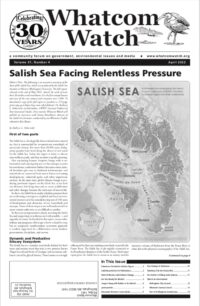by Ed Johnstone
My mentor Billy Frank Jr. always said salmon are the measuring stick of our survival.
He was referring to all of us.
Salmon are the keystone that supports dozens of other species of fish and wildlife. Their survival, and ours, depends on clean, cool, flowing rivers and streams.
We had an opportunity to protect those waters with the Lorraine Loomis Act, proposed by Gov. Jay Inslee and named for NWIFC’s former chairperson, who passed away last year. Lorraine knew protecting riparian habitat is essential to salmon recovery. She wanted nothing more than to ensure future generations of Washingtonians could experience what it means to have healthy salmon runs and the joy of salmon fishing.
We understand that the bill is not progressing in the state Legislature this year, but that doesn’t mean the work stops. It can’t.
We’re already behind schedule. It’s been 10 years since Billy said, “We are at a crossroads and we’re running out of time.”
The Lorraine Loomis Act was a starting point that sought to protect and grow trees in the riparian zones along salmon and steelhead streams. It also would have provided financial assistance to help landowners comply with the law. It would have included a regulatory backstop for those unwilling to comply.
Tribes have been pushing for legislation like this for years. But this isn’t an “Indian bill.” Numerous environmental groups as well as recreational and commercial fishing organizations have supported it because they understand we’re all in this together. They have prioritized salmon restoration because they know how critical the situation is.
Tribes are bearing the burden of fixing a problem we didn’t create.
Our hatcheries release more than 35 million salmon and steelhead every year and we have restored thousands of miles of habitat. But habitat destruction has run rampant, and the state has failed to do enough about it. Our people are hungry and there’s no end in sight.
Climate change is a primary culprit. Temperatures in streams are the highest on record. After last summer’s extreme heat wave, more than 2,500 Chinook salmon died on the South Fork Nooksack River before they could reach the Lummi Nation’s Skookum Creek hatchery, because of lethal temperatures for salmon and low flows. Improved riparian conditions and channel complexity could have prevented this tragedy.
If the Lorraine Loomis Act had passed this year, it would have helped prevent more such tragedies in the years to come. As it is, the number of temperature-impaired salmon stream segments in our United States v. Washington case area has increased from 400 to 2,000 over the past few decades.
Getting trees in the ground is the first step toward protecting riparian habitat. It’s a small step, but an important one that requires a long-term commitment. The treaty tribes are committed to this work. It’s going to take at least 40 years before trees grow enough to protect our salmon streams. Additional habitat restoration is needed, and we need to build capacity and infrastructure to do the work – now.
Yes, there are those who oppose these critical efforts. Some in the agricultural industry seem to think creating riparian management zones puts the burden of salmon recovery on them. They claim it could harm their businesses. It’s a short-sighted attitude given the fact that protecting streams, rivers and the environment is an investment in their future as well as ours. Also, failing to protect salmon habitat violates treaty tribes’ federally protected right to harvest salmon.
We’ve already lost more than 90 percent of our salmon harvest. We aren’t asking farmers to give up 90 percent of their livelihood. Planting trees won’t put anyone out of business. It won’t impede the economy, the environment or the Northwest way of life. Quite the opposite.
Fully functioning riparian habitats provide bank stability, shade, pollution control and the large woody debris salmon need to survive. The lack of these habitats eats away evermore at our precious way of life.
There is no more time to waste. The state needs to get serious about re-establishing riparian habitats – now.
_______________________
Ed Johnstone is chairman of the Northwest Indian Fisheries Commission (www.nwifc.org). This column represents the natural resources management interests and concerns of the treaty Indian tribes in western Washington.




























